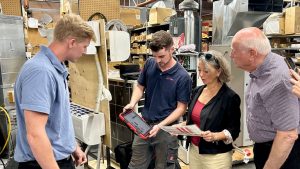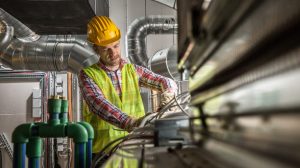It’s been at least 30 years since someone coined the phrase "sick-building syndrome." The phrase became something of an instant diagnosis.
Sneeze and someone would say you were suffering from sick-building syndrome.
Rub your eyes after reading for a couple of hours. Sick-building syndrome.
Inevitably, building-management systems improved and complaining stopped.
People liked the better indoor environments. They felt better and they did better work.
Score one for building science.
Now other disciplines are getting involved.
A new study by researchers from Harvard University shows the importance of a building’s interior environment as it relates to productivity and overall health. It seems the keys to working better, sleeping better and feeling better could be rooted in the design, maintenance and operation of the buildings where we spend so much of our time.
Researchers looked at 10 high-performing buildings in five cities across the United States. They found that occupants in high-performing, green-certified office environments scored 26 per cent higher on tests of cognitive function, than occupants of non-certified buildings.
As well, 30 per cent reported fewer symptoms (red, itchy eyes, runny nose and the like) of sick-building syndrome. Six per cent had higher sleep quality scores.
None of this should surprise anyone. We’ve known for years that people are happier and more productive when they have a healthy workspace. That’s why building owners and managers are asking for smarter buildings, which, in turn, leads to more sophisticated building management systems.
What interests me the most about this latest study is that it wasn’t done by building scientists.
The researchers came from the Centre for Health and the Global Environment, which is part of Harvard’s T. H. Chan School Of Public Health. Working with them were researchers with SUNY Upstate Medical University.
The present research is the second of two projects done by the team. Late in 2015 it published the finding that cognitive function scores doubled when participants were in a simulated green building environment with enhanced ventilation. The present study was done away from the lab, in real offices in real buildings.
So there has been a merger of sorts. That, says Joseph Allen, principal investigator of the school’s Healthy Buildings program, has resulted in "buildingomics," which merges building science with health science.
Buildingomics is a new approach that examines all of the factors in the building-related environment that can influence human health, well-being and productivity.
"We are passionate about moving science out of the public health journals and into the hands of decision-makers," Allen says.
Jack Spengler, one of the principal investigators in the study, says that "when you think of the urbanization that is going on around the world, we will see a doubling of our built environment before the century is over.
"We better do it right — energy-wise, material-wise — and optimize the human condition in those environments."
To help, the school has developed a 36-page document called The 9 Foundations of a Healthy Building. It’s a concise synthesis of 30 years of scientific data on the key elements that make buildings healthy.
Allen apparently kept hearing that while research is interesting, one couldn’t take a scientific paper into a meeting to convince the building owner or manager to do things differently. A short summary was needed and the 9 Foundations project was born.
This 36-pager will eventually turn into a series under the general heading of Building Evidence for Health.
Multidisciplinary research is always interesting since it brings together two, three or more academic disciplines. This marriage between building science and health science should be an interesting one to follow.
If you want a copy of The 9 Foundations of a Healthy Building, you can download it at http://9foundations.forhealth.org.
If you want a copy of the study, it’s at http://naturalleader.com/thecogfxstudy/.
If you want to know more about how building science and health science are getting along, visit www.forhealth.org.
Korky Koroluk is an Ottawa-based freelance writer. Send comments to editor@journalofcommerce.com.










Recent Comments
comments for this post are closed